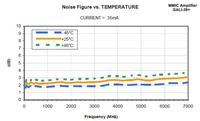Synaps3
Member level 1
What type of amplifier typically has more noise, a MMIC or a transistor amplifier? Most of the MMICs seem to have a noise figure around 3dB. What is the noise figure range for a transistor amplifier?
In other words, if I'm looking to design an amplifier with the lowest noise possible, should I use an MMIC or transistor type amplifier?
In other words, if I'm looking to design an amplifier with the lowest noise possible, should I use an MMIC or transistor type amplifier?
